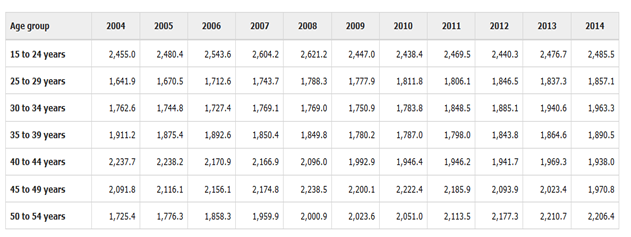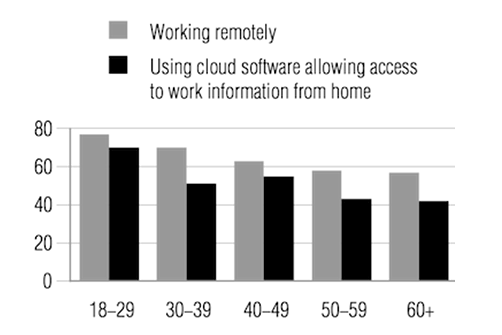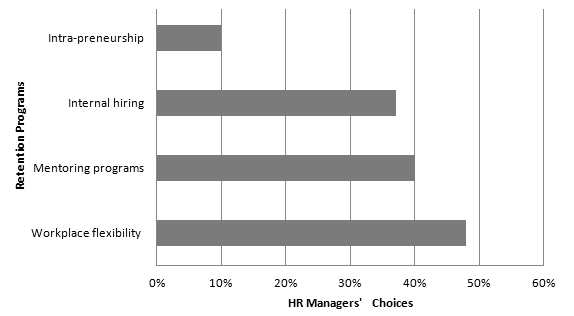The paper provides the results of the descriptive research on the generational differences in the workforce of Canada. The aspects of the work with Millennials and its effects on the organizational performance were studied with the focus on the data provided by Statistics Canada and other agencies. It was found that the number of Millennials, or representatives of Generation Y, in the Canadian labor force is high, and this fact influences the human resource managers’ practices to improve the organizational performance.
The main positive feature of working with Millennials is their orientation to innovations and changes. However, Millennials’ focus on flexible working conditions, high compensation level, and opportunities for the personal and career development influence the turnover rates and the organizational performance accordingly.
The multigenerational workforce is a typical feature of the labor environment in Canada. This situation is rather challenging as several generations are characterized by different approaches to the work, and managers need to address a variety of perspectives that are associated with the visions of these generations. In this context, much attention is paid to the work with Millennials (Generation Y), the employees born during the period of 1980-2000 (Bott, Faulk, Guntupalli, Devaraj, & Holmes, 2011).
The problem is in the fact that the demographical features of the Canadian workforce change, and today, it is possible to observe the tendency according to which managers focus on attracting more Millennials to organizations. From this point, the important question to pose is what effects generational differences in the workforce can have on the organizations’ performance. The question is significant to be researched and discussed in detail, and the purpose of this paper is to examine the generational differences with the focus on Millennials’ work and explore the possible effects on organizations.
Literature Review
Millennials at the workplace are usually discussed as employees who quickly study, actively use technological devices and systems, and accept the necessity of changes and improvements more positively in comparison to representatives of other generations (Balda & Mora, 2011; Myers & Sadaghiani, 2010). As a consequence, managers choose Millennials to coordinate the implementation of computer systems and monitor projects directed to increasing the innovativeness factor in the organization (Gentry, Deal, Griggs, Mondore, & Cox, 2011; Hartman & McCambridge, 2011; Ismail & Lu, 2014).
Kaifi, Nafei, Khanfar, and Kaifi (2012) and Ng and Gossett (2013) note that in comparison to Generation X (those people, who were born in 1965-1979), Generation Y avoids choosing the work in the public sector because of the high level or regulations and comparably low salaries. De Caluwe, Van Dooren, Delafortry, and Janvier (2014) associate this tendency with the orientation of Millennials to the personal development and improvement of the financial state. Cahill and Sedrak (2012) add that Millennials are inclined to invest in education in order to increase their professional level, but they also expect that employers will invest in their training and development, as well as address their needs and interests. These aspects seem to contribute to improving the organizational performance.
At the workplace, Generation X and Generation Y also have many similar features that influence their performance. These features are valuing education, representing the autonomy, and the attitudes to authority (Brown, 2012; Kilber, Barclay, & Ohmer, 2014).
However, differences are observed in these categories. Although the representatives of Generation X are inclined to act decisively and argue their position, they accept the hierarchy at the workplace while focusing on the collaboration with leaders (Cekada, 2012; Wils, Saba, Waxin, & Labelle, 2011). On the contrary, Millennials do not accept hierarchy in the traditional way, and they choose to demonstrate their potential and achievements to be respected equally to other professionals (DelCampo, 2012; Trzesniewski & Donnellan, 2010). The positive effect on the organizational performance is direct because Millennials try to do their best to perform as the high-class professionals.
However, Thomas, Brown, and Bosselman (2015) note that Millennials oriented to make a difference and complete meaningful tasks are inclined to change jobs actively, influencing the human resource management in the concrete organizations. Nevertheless, if the benefits, work flexibility, and the working environments are viewed by Millennials as supportive, they can stay with the organization during a long period of time. Suleman and Nelson (2011) note that, in this case, Millennials focus on realizing their professional potential and making a change.
Methods
The quantitative methodology with the focus on the descriptive study was chosen to address the purpose of the research. The statistical data for the analysis were retrieved from the online databases of Statistics Canada, the national statistical agency in the country (Government of Canada, 2015). The data on the labor force categorized according to the employees’ age for the period of 2004-2014 and generational differences were retrieved for the study. Additionally, the data were collected from the reports provided by the Conference Board of Canada (2015) and Millennial Branding (2013). The collected data on the age characteristics and generational differences of the Canadian workforce were analyzed with the focus on the descriptive analysis.
Data Analysis
Three categories of data were selected for the analysis. Firstly, the data on the proportion of working generations were examined to state what percentage of Millennials works in Canadian organizations. Secondly, the data on the workers’ flexibility and willingness to work remotely were explored to conclude about generational differences. Next, the data on integrating human resource management programs to retain Millennials was studied to conclude about the effects of generational differences at the workplace.
Table 1 presents the data of Statistics Canada on the number of persons working in Canadian organizations during the period of 2004-2014 and categorized according to their age.

The data on the labor force in Canada indicates that in comparison to 2004, the number of 15-24-year-old workers did not change significantly. However, the number of 25-29-year-old persons working in Canadian organizations increased by 13% in comparison to 2004. While discussing both 15-24-year-old persons and 25-29-year-old persons as the group of Millennials, it is possible to state that in comparison to 30-39-year-old employees, the number of working Millennials increased by 12%, and in comparison to 40-49-year-old employees, the increase is 10%. As a result, in 2014, the Millennials represented the largest labor force category in Canada, and it is possible to speak about the tendency’s progress.
Figure 1 provides the results of the report on the Canadian workers’ willingness to work remotely and using the cloud software presented by the Conference Board of Canada.

According to Figure 1, more than 75% of 18-29-year-old employees (Millennials) are inclined to work remotely and using technologies. More than 60% of 30-49-year-old employees (Generation X) are also ready to work remotely, but the number of Baby Boomers prepared to work remotely and use specific technologies is significantly lower (less than 60%). These data indicate the readiness of Millennials to choose the flexible work options.
Figure 2 indicates what programs are implemented by human resource managers not only in Canada but also in the United States in order to address the Millennials’ needs at the workplace.

According to Millennial Branding (2013), human resource managers report the high level of turnover among Millennials, and this aspect increases the overall performance of the organization because of the necessity to recruit new employees, build new teams, and spend resources on training. The data analysis demonstrates that some companies implement retention programs to retain Millennials and decrease the negative financial and performance effects of their turnover.
About 50% of companies develop programs guaranteeing the workplace flexibility for Generation Y, and 40% managers integrate mentoring programs in order to support Millennials. These results indicate that employers are ready to provide the comfortable conditions for Millennials to increase their retention and avoid the negative outcomes of these’ employees’ turnover.
Discussion
The analysis of the statistical data and survey results on the labor force in Canada indicate that the number of working Millennials increased significantly during a recent decade. This situation created affected the human resource management in terms of developing the strategies for managing generational differences and decreasing the negative impact of the observed tendency. Berry, Cole, and Hembroff (2011) and Lyons and Kuron (2014) state that it is a normal practice to attract the young professionals to work in the Canadian organizations and firms, and today this age category is rather large.
However, Generation Y differs significantly from representatives of Generation X in terms of their attitude to the work, technologies, and innovations. More Millennials choose to work remotely, telecommuting, and the active use of technologies because flexibility, the work-life balance, and the use of the significant technological base are the priorities for this generation, as it is stated by Bannon, Ford, and Meltzer (2011) and Coulter and Faulkner (2014).
As a result, to increase the organizational performance, the human resource managers try to address Millennials’ needs and interests. Dols, Landrum, and Wieck (2010) note that the reason to rely on the work of Millennials rather than representatives of the previous generation is the necessity to respond to the global market development, increase the competitive advantage, and improve the technological basis of processes. Millennials usually have the high-quality education and developed communication, computer, and negotiation skills (Berry, 2013; North & Fiske, 2015; Twenge, Campbell, Hoffman, & Lance, 2010). These qualities are attractive for human resource managers recruiting Millennials in Canadian companies.
Nevertheless, in comparison to other generations, the work with Millennials is characterized by the higher risk of turnover, and this factor influences the organizational performance negatively. Ng, Schweitzer, and Lyons (2010) explain this tendency with the focus on the fact that Generation Y is concentrated on finding the most beneficial conditions regarding the payments, benefits, and the career growth. Thus, the readiness of innovations and changes of Millennials has the adverse effects, and the data analysis reveals that human resource managers should propose the retention strategies not only for experienced workers belonging to Generation X but also to Generation Y.
The most actively chosen retention programs propose the increased flexibility and mentoring programs because these strategies address the main qualities of Millennials. It is more advantageous for the Canadian employers and managers to retain high-quality Millennials than recruiting new candidates, and the development of this tendency can be predicted in the future because the labor force in Canada becomes “younger”, and human resource managers should address these changes adequately.
Conclusion
The number of working Millennials increases each year, and the managers’ focus on this age category of the workforce can be discussed as a logical consequence of the labor market’s progress. Currently, human resource managers in the Canadian organizations need to pay more attention to addressing the needs of Millennials in order to increase the performance. On the one hand, the organizational performance improves as managers can integrate more flexible programs and schedules, implement changes, actively use technologies, orient to innovations, develop communication channels, and increase the competitive advantage with the focus on the highly developed skills of Millennials.
On the other hand, the risk for the organizational performance is in the high turnover rate associated with the representatives of Generation Y. Millennials are interested in finding the position with the competitive salary and opportunities for the career development. Still, this situation negatively influences the organizational performance because managers need to find new employees or train the other ones to cover positions. The retention programs are developed to address the generational issues in the sphere of management.
References
Balda, J. B., & Mora, F. (2011). Adapting leadership theory and practice for the networked, Millennial generation. Journal of Leadership Studies, 5(3), 13-24.
Bannon, S., Ford, K., & Meltzer, L. (2011). Understanding Millennials in the workplace. CPA Journal, 81(11), 61-65.
Berry, J. (2013). Canadian public relations students’ interest in government communication. Management Research Review, 36(5), 528-534.
Berry, J., Cole, R., & Hembroff, L. (2011). US-Canada study of PR writing by entry-level practitioners reveals significant supervisor dissatisfaction. Journal of Professional Communication, 1(1), 8-19.
Bott, J., Faulk, D., Guntupalli, A., Devaraj, S., & Holmes, M. (2011). An examination of generational differences and media exposure. The Journal of Applied Management and Entrepreneurship, 16(4), 78-100.
Brown, S. (2012). Attracting, challenging, and leading a multigenerational workforce – a perspective. Frontiers of Health Services Management, 29(1), 29-38.
Cahill, T. F., & Sedrak, M. (2012). Leading a multigenerational workforce: Strategies for attracting and retaining millennials. Frontiers of Health Services Management, 29(1), 3-12.
Cekada, T. L. (2012). Training a multigenerational workforce. Professional Safety, 57(3), 40-44.
Coulter, J. S., & Faulkner, D. C. (2014). The multigenerational workforce. Professional Case Management, 19(1), 46-51.
De Caluwe, C., Van Dooren, W., Delafortry, A., & Janvier, R. (2014). Mind-sets of boundary less careers in the public sector the vanguard of a more mobile workforce? Public Personnel Management, 43(4), 14-29.
DelCampo, R. G. (2012). Managing the multigenerational workforce: From the GI generation to the millennials. Human Resource Management International Digest, 20(2), 12-34.
Dols, J., Landrum, P., & Wieck, K. (2010). Leading and managing an intergenerational workforce. Creative Nursing, 16(2), 68-74.
Gentry, W. A., Deal, J. J., Griggs, T. L., Mondore, S. P., & Cox, B. D. (2011). A comparison of generational differences in endorsement of leadership practices with actual leadership skill level. Consulting Psychology Journal: Practice & Research, 63(1), 39-49.
Government of Canada. (2015). Statistics Canada: Labor force survey estimates (LFS), by sex and detailed age group. Web.
Hartman, J. H., & McCambridge, J. (2011). Optimizing Millenials’ communication styles. Business Communication Quarterly, 74(1), 22-44.
Ismail, M., & Lu, H. (2014). Cultural values and career goals of the millennial generation: An integrated conceptual framework. Journal of International Management Studies, 9(1), 38-46.
Kaifi, B. A., Nafei, W. A., Khanfar, N. M., & Kaifi, M. M. (2012). A multi-generational workforce: Managing and understanding millennials. International Journal of Business and Management, 7(24), 88-95.
Kilber, J., Barclay, A., & Ohmer, D. (2014). Seven tips for managing Generation Y. Journal of Management, 15(4), 81-89.
Lyons, S., & Kuron, L. (2014). Generational differences in the workplace: A review of the evidence and directions for future research. Journal of Organizational Behavior, 35(1), 139-157.
Millennial Branding. (2013). Millennial Branding and Beyond.com survey. Boston, MA: Author.
Myers, K. K., & Sadaghiani, K. (2010). Millennials in the workplace: A communication perspective on millennials’ organizational relationships and performance. Journal of Business and Psychology, 25(2), 225-238.
Ng, E. S., & Gossett, C. W. (2013). Career choice in Canadian public service: An exploration of fit with the millennial generation. Public Personnel Management, 42(3), 337-358.
Ng, E. S., Schweitzer, L., & Lyons, S. T. (2010). New generation, great expectations: A field study of the millennial generation. Journal of Business and Psychology, 25(2), 281-292.
North, M. S., & Fiske, S. T. (2015). Intergenerational resource tensions in the workplace and beyond: Individual, interpersonal, institutional, international. Research in Organizational Behavior, 35(1), 159-179.
Suleman, R., & Nelson, B. (2011). Motivating the Millennials: Tapping into the potential of the youngest generation. Leader to Leader, 2011(62), 39-44.
The Conference Board of Canada. (2015). Canada’s Telecommunications Industry: Industrial outlook spring 2015. Ottawa, Canada: Author.
Thomas, N. J., Brown, E. A., & Bosselman, R. H. (2015). Are they leaving or staying: A qualitative analysis of turnover issues for Generation Y hospitality employees with a hospitality education. International Journal of Hospitality Management, 46(1), 130-137.
Trzesniewski, K. H., & Donnellan, M. B. (2010). Rethinking “Generation Me”: A study of cohort effects from 1976–2006. Perspectives on Psychological Science, 5(1), 58–75.
Twenge, J. M., Campbell, S. M., Hoffman, B. J., & Lance, C. E. (2010). Generational differences in work values: Leisure and extrinsic values increasing, social and intrinsic values decreasing. Journal of Management, 36(1), 1117–1142.
Wils, T., Saba, T., Waxin, M. F., & Labelle, C. (2011). Intergenerational and intercultural differences in work values in Quebec and the United Arab Emirates. Relations Industrielles/Industrial Relations, 66(3), 445-469.